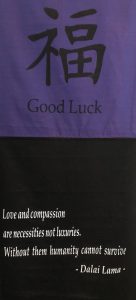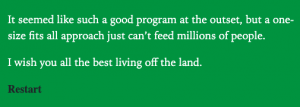In our final week of the course, all of my peers created exceptional presentations of dystopias, utopias, and the direction of where technology might end up moving forward.
 One peer in particular, Margaret Irwin, a Foods Teacher, chose to imagine and design a twine game where all citizens have “equal access to food.” The game pits a government subsidized program against independent organic model in order to envision food equity and equality of the future. What went wrong? Was there too much change too quickly?
One peer in particular, Margaret Irwin, a Foods Teacher, chose to imagine and design a twine game where all citizens have “equal access to food.” The game pits a government subsidized program against independent organic model in order to envision food equity and equality of the future. What went wrong? Was there too much change too quickly?
The game is powerful as it provides autonomy for the player, but only once. “You must make a choice today.” This is the power of conscious decision making, of reflecting on the permanence and impermanence of our individual and collective actions. The language used throughout the game is subtle, yet powerful. The ‘considerations’ one must make in organic farmer, as opposed to the ‘implications’ of following a government run food program. Both options for the future of food are presented as positive sustainable options, yet the underlying factors of homogenizing a population through the one-size-fits-all approach aligns with many of the themes explored in dystopian predications from our class, including increased reliance and dependence, skill degeneration, hacking the algorithm, and loss of practices.

Margaret’s blog is provides many links for accessing past work and comments, as opposed to my scrollable interface. Her blog presents the title and date before the title, unlike my own. In my blog entry, I provided a visualization which prompted my narratives of a grassroots educational setting and an elitist technological economy. Providing an audio narrative gave emotion and pace to the community focused narrative, while an angular word cloud and text provide information on the socially detached possibility. Margaret was able demonstrate this distinction within one medium, Twine. Using the viewers agency, she developed an interactive hypertext game with two paths for the future of food, similarly, I created my blog as a continuous document, one continuous path of my process and development.